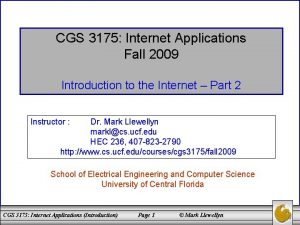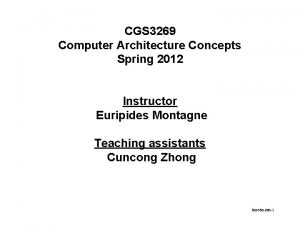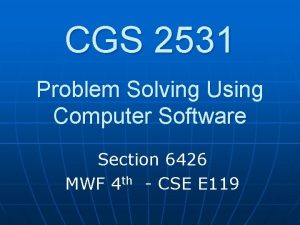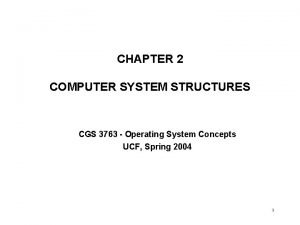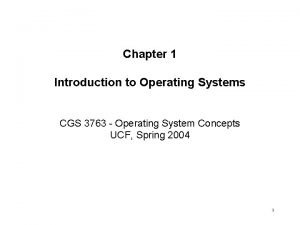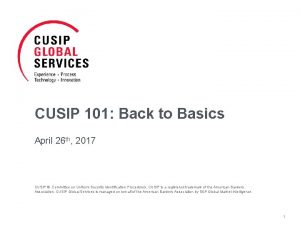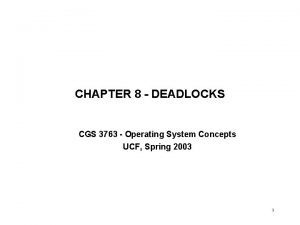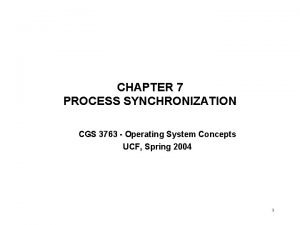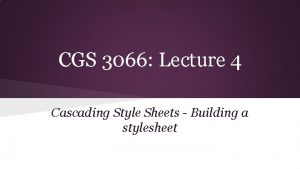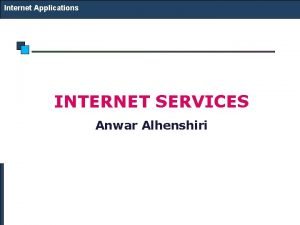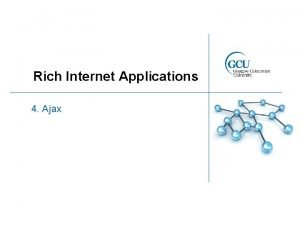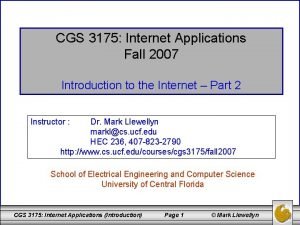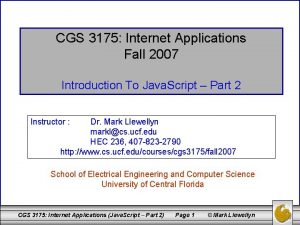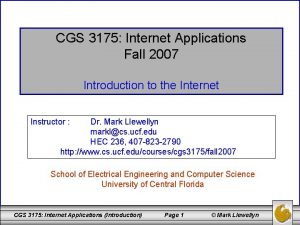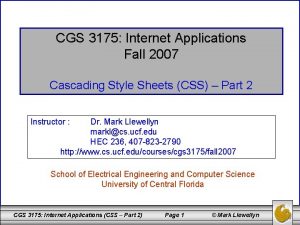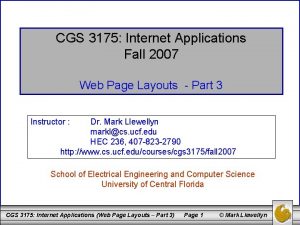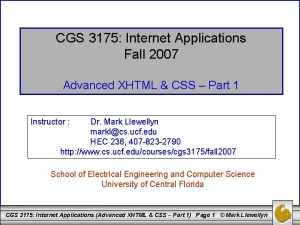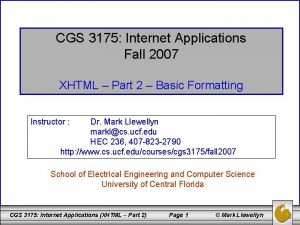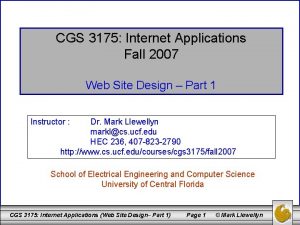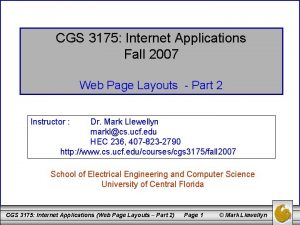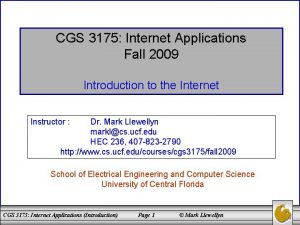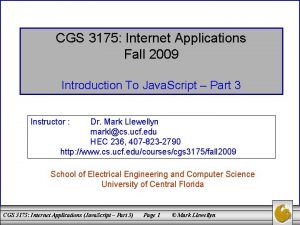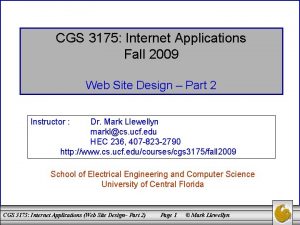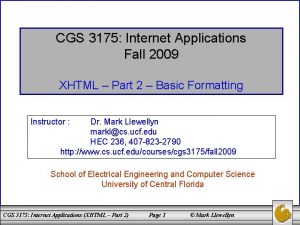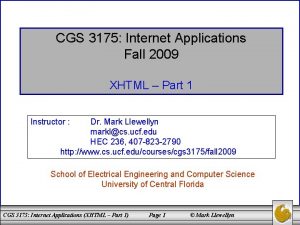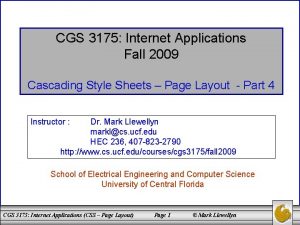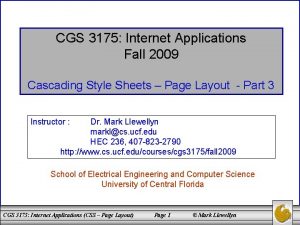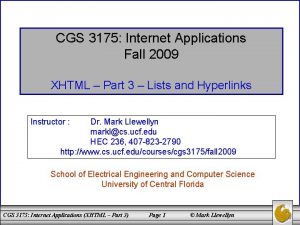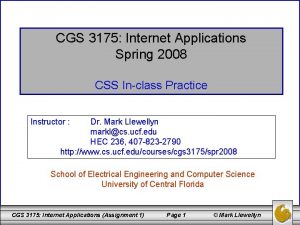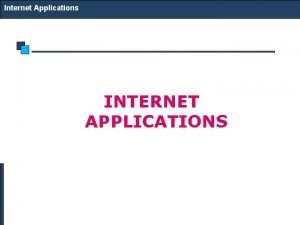CGS 3175 Internet Applications Fall 2007 Introduction To

























- Slides: 25

CGS 3175: Internet Applications Fall 2007 Introduction To Java. Script – Part 1 Instructor : Dr. Mark Llewellyn markl@cs. ucf. edu HEC 236, 407 -823 -2790 http: //www. cs. ucf. edu/courses/cgs 3175/fall 2007 School of Electrical Engineering and Computer Science University of Central Florida CGS 3175: Internet Applications (Java. Script – Part 1) Page 1 © Mark Llewellyn

Things to Try Yourself (From Advanced XHTML & CSS – Part 3) 22. Create an external CSS style sheet for the XHTML document shown on the next page that will produce the browser version and print version which are shown on page 33. • Note: you will need to slightly modify the XHTML document by (1) adding the link tag for the external style sheet and (2) modifying the paragraph tags for the style sheet identifiers you create. • Note: The border on the screen version is 5 px wide and on the print version it is 10 pt wide. The font size for the paragraphs is set at 16 pt. CGS 3175: Internet Applications (Java. Script – Part 1) Page 2 © Mark Llewellyn

<? xml version="1. 0" encoding="UTF-8"? > <!DOCTYPE html PUBLIC "-//W 3 C//DTD XHTML 1. 0 Strict//EN" "http: //www. w 3. org/TR/xhtml 1/DTD/xhtml 1 -strict. dtd"> <html xmlns="http: //www. w 3. org/1999/xhtml"> <head> <title>Practice Problem 22 </title> </head> <body> <p> The media attribute lets you control what styles are applied to which media. PC and Mac browsers use the values <i>print</i>, <i>all</i>, and <i>screen</i> but there are many more media types as shown in the table on page 13 of this set of notes. </p> <p> The @media rule can also be used to control styles based on the medium, but it can do so directly from the style sheet, with no need for XHTML. </p> <p> The @media rule simply wraps the rules that are to be applied to a particular medium. </p> </body> </html> CGS 3175: Internet Applications (Java. Script – Part 1) Page 3 © Mark Llewellyn

The browser version of the document CGS 3175: Internet Applications (Java. Script – Part 1) Page 4 © Mark Llewellyn

The print version of the document CGS 3175: Internet Applications (Java. Script – Part 1) Page 5 © Mark Llewellyn

Modified XHTML For Practice Problem 22 <? xml version="1. 0" encoding="UTF-8"? > <!DOCTYPE html PUBLIC "-//W 3 C//DTD XHTML 1. 0 Strict//EN" "http: //www. w 3. org/TR/xhtml 1/DTD/xhtml 1 -strict. dtd"> <html xmlns="http: //www. w 3. org/1999/xhtml"> <head> <title>Practice Problem 22 </title> <link rel="stylesheet" href="practice problem 22 CSS. css" media="all" type="text/css" /> </head> <body> <p id="screen"> The media attribute lets you control what styles are applied to which media. PC and Mac browsers use the values <i>print</i>, <i>all</i>, and <i>screen</i> but there are many more media types as shown in the table on page 13 of this set of notes. </p> <p id="print" class="before"> The @media rule can also be used to control styles based on the medium, but it can do so directly from the style sheet, with no need for XHTML. </p> <p> The @media rule simply wraps the rules that are to be applied to a particular medium. </p> </body> </html> CGS 3175: Internet Applications (Java. Script – Part 1) Page 6 © Mark Llewellyn

CSS For Practice Problem 22 /* CSS for Practice Problem 22 */ p { font: 16 px sans-serif; background: yellow; padding: 10 px; text-align: justify; } @media screen { p#print { display: none; } p#screen { border: 5 px solid blue; } } @media print { padding: 0. 05 in; } p#print { border: 10 pt solid red; }. before { page-break-before: always; } p#screen { display: none; } } CGS 3175: Internet Applications (Java. Script – Part 1) Page 7 © Mark Llewellyn

Introduction to Java. Script • Before we go any further let’s get one thing very clear: Java. Script is not Java! • Java. Script is a scripting language. (XHTML is a mark-up language. ) • Using Java. Script, you can incorporate techniques and effects that will make your Web pages come alive for the visitor allowing them a great deal of interaction with your site. • We’ll examine many aspects of Java. Script as we go along, but first some background material. CGS 3175: Internet Applications (Java. Script – Part 1) Page 8 © Mark Llewellyn

Server-side and Client-side Programming • Server-side scripts are programs that reside on a Web server and are executed on behalf of a client (in response to their requests typically from elements in Web pages). – For example, in assignment #4 you are utilizing a serverside script (written in PHP which is a server-side scripting language) to process the contents of your XHTML form. 1. Form data sent to program on server for processing. BROWSER 2. Results sent back to the client for display. Client CGS 3175: Internet Applications (Java. Script – Part 1) Webserver Page 9 © Mark Llewellyn

Server-side and Client-side Programming • Client-side scripts are programs that reside on the client’s machine (they are downloaded to your machine as part of the Web browser’s cache memory) and are executed on behalf of the client’s request. BROWSER Client-side processing with Java. Script embedded in XHTML – portable code Client CGS 3175: Internet Applications (Java. Script – Part 1) Webserver Page 10 © Mark Llewellyn

Server-side and Client-side Programming • While there are certain advantages to client-side scripting, client-side programs can never completely replace server-side scripts. • Tasks such as running a search form of processing a purchase order or e-commerce situations must be run from a central server because only the server has connections to the databases needed to complete these types of operations. • Indeed one of the primary reasons for using a server-side scripting language is to develop interactive Web sites that communicate with a database. • With this is mind a more realistic picture of typical clientserver interaction is shown on the next page where both clientside and server-side processing are occurring in parallel. CGS 3175: Internet Applications (Java. Script – Part 1) Page 11 © Mark Llewellyn

Server-side and Client-side Programming 1. Java. Script in XHTML BROWSER 3. Some data sent to server for processing. Database server Webserver 2. Client-side processing with Java. Script 5. Results sent to client for display in browser. Server-side script connects to database server – database activity ensues. (Note: two-way connection. Database Typical Client-Server Web Interaction CGS 3175: Internet Applications (Java. Script – Part 1) data Client 4. Page 12 © Mark Llewellyn

Server-side and Client-side Programming • Java. Script is a client-side object-oriented scripting language that is interpreted by a Web browser. • Java. Script is considered object-oriented because it is used to work with the objects associated with a Web page document: the browser window, the document itself, and the elements such as forms, images, and links contained within the page. CGS 3175: Internet Applications (Java. Script – Part 1) Page 13 © Mark Llewellyn

How To Use Java. Script • Java. Script is designed to work inside Web pages and within Web browsers. In this spirit, it extends the XHTML philosophy of using tags. • The <script> tag is used to embed Java. Script in XHTML documents. • The <script> tag can appear either in the HEAD or BODY sections of an XHTML document. • Comments within the <script> tag, i. e. , Java. Script comments begin with /* and end with */. If the comment fits on a single line you can use // to start the comment with no ending delimiter. CGS 3175: Internet Applications (Java. Script – Part 1) Page 14 © Mark Llewellyn

A Java. Script Enhanced Web Page – Version 1 The Java. Script appearing in the HEAD of the XHTML document. <? xml version="1. 0" encoding="UTF-8"? > <!DOCTYPE html PUBLIC "-//W 3 C//DTD XHTML 1. 0 Strict//EN" "http: //www. w 3. org/TR/xhtml 1/DTD/xhtml 1 -strict. dtd"> <html xmlns="http: //www. w 3. org/1999/xhtml"> <head> <title>A First Java. Script Enhanced Web Page </title> <script type=“text/javascript”> //this script simply pops up an alert window. alert(“A web browser will follow your instructions exactly and without an argument. ”); </script> <style type=“text/css”> <!-- body {background-color: yellow; } --> </style> </head> <body> <h 1> Isn’t it nice how computers do what they are told? </h 1> </body> </html> CGS 3175: Internet Applications (Java. Script – Part 1) Page 15 © Mark Llewellyn

A Java. Script Enhanced Web Page – Version 1 First screen CGS 3175: Internet Applications (Java. Script – Part 1) Second screen Page 16 © Mark Llewellyn

A Java. Script Enhanced Web Page – Version 2 <? xml version="1. 0" encoding="UTF-8"? > <!DOCTYPE html PUBLIC "-//W 3 C//DTD XHTML 1. 0 Strict//EN" "http: //www. w 3. org/TR/xhtml 1/DTD/xhtml 1 -strict. dtd"> <html xmlns="http: //www. w 3. org/1999/xhtml"> <head> <title> A First Java. Script Enhanced Web Page </title> <style type="text/css"> <!-- body {background-color: yellow; } --> </style> </head> <body> <script type="text/javascript"> //this script simply pops up an alert window. alert("A Web browser will follow your instructions exactly without an argument. "); </script> <h 1>Isn't it nice how computers do what they are told? </h 1> </body> </html> CGS 3175: Internet Applications (Java. Script – Part 1) Page 17 The Java. Script appearing in the BODY of the XHTML document. and © Mark Llewellyn

A Java. Script Enhanced Web Page – Version 2 First screen Note that the internal CSS in the HEAD of the XHTML document has already rendered the background color. CGS 3175: Internet Applications (Java. Script – Part 1) Second screen Page 18 © Mark Llewellyn

A Java. Script Enhanced Web Page – Version 3 <? xml version="1. 0" encoding="UTF-8"? > <!DOCTYPE html PUBLIC "-//W 3 C//DTD XHTML 1. 0 Strict//EN" "http: //www. w 3. org/TR/xhtml 1/DTD/xhtml 1 -strict. dtd"> <html xmlns="http: //www. w 3. org/1999/xhtml"> <head> The Java. Script <title> A First Java. Script Enhanced Web Page </title> appearing in the <style type="text/css"> BODY of the <!-- body {background-color: yellow; } XHTML document, --> but after the line of </style> text. </head> <body> <h 1>Isn't it nice how computers do what they are told? </h 1> <script type="text/javascript"> //this script simply pops up an alert window. alert("A Web browser will follow your instructions exactly and without an argument. "); </script> </body> </html> CGS 3175: Internet Applications (Java. Script – Part 1) Page 19 © Mark Llewellyn

A Java. Script Enhanced Web Page – Version 3 Note that the line of text appears at the same time as the alert window (actually it appears first, but is very rapidly followed by the alert window since it is rendered in normal flow). Only screen CGS 3175: Internet Applications (Java. Script – Part 1) Page 20 © Mark Llewellyn

How To Use Java. Script • In keeping with the modern convention of separating content from presentation in Web pages, another very common technique for locating scripts is to place them in a file external to the XHTML document in which they will be activated. • As we did with CSS, where one external style sheet could be used by several different XHTML documents to style their presentation, we can do the same with scripts. • By creating a library (a file) of scripts in an external file and linking the XHTML pages to the library any XHTML document can utilize any of the scripts in the library. • The next couple of pages we’ll rework the same example, but this time use an external library for the script itself. CGS 3175: Internet Applications (Java. Script – Part 1) Page 21 © Mark Llewellyn

A Java. Script Enhanced Web Page – Version 4 <? xml version="1. 0" encoding="UTF-8"? > <!DOCTYPE html PUBLIC "-//W 3 C//DTD XHTML 1. 0 Strict//EN" "http: //www. w 3. org/TR/xhtml 1/DTD/xhtml 1 -strict. dtd"> <html xmlns="http: //www. w 3. org/1999/xhtml"> <head> The <script> tag appears <title> A First Java. Script Enhanced Web Page </title> in the HEAD section of <style type="text/css"> the XHTML document <!-- body {background-color: yellow; } and references a script --> library named </style> “myscriptlibrary. js”. (As <script type="text/javascript" src="myscriptlibrary. js"> with images, the “src” </script> attribute is specified by a </head> URL. ) <body> <h 1>Isn't it nice how computers do what they are told? </h 1> </body> </html> CGS 3175: Internet Applications (Java. Script – Part 1) Page 22 © Mark Llewellyn

A Java. Script Enhanced Web Page – Version 4 /* This is my Java. Script library of scripts */ //this script is used in the first few Java. Script examples. window. alert("A Web browser will follow your instructions exactly and without an argument. "); Version 4 behaves exactly as our first version did. The use of an external library for scripts will make more sense when we start writing Java. Script functions. For a simple case like the one shown here, there is little justification for an external script. Second screen First screen CGS 3175: Internet Applications (Java. Script – Part 1) The actual script is unchanged in this library file. Page 23 © Mark Llewellyn

Things to Try Yourself 23. Create a 5 th and 6 th version of the XHTML document in this set of notes using the external script library. In version 5, put the <script> element before the <h 1> element and in version 6, put the <script> element after the <h 1> element. What effect does this have on the way the browser displays the page? Is the effect similar to any of the other versions we already created? 24. Using version 2 (page 17) of the XHTML document in this set of notes as a template. Modify the document using the Java. Script statement document. writeln(“ your text here “); so that the new version of the document simply prints the message in the user’s browser as shown on the next page. CGS 3175: Internet Applications (Java. Script – Part 1) Page 24 © Mark Llewellyn

Things to Try Yourself Your message can vary CGS 3175: Internet Applications (Java. Script – Part 1) Page 25 © Mark Llewellyn
 Cgs 3175
Cgs 3175 Cgs 3269
Cgs 3269 Cgs2531
Cgs2531 Cgs 1060 ucf
Cgs 1060 ucf Cgs 3763 ucf
Cgs 3763 ucf Cse 598
Cse 598 Cgs 3763
Cgs 3763 Cgs homepage
Cgs homepage Cgs 2518 fsu
Cgs 2518 fsu Cgs medicare credit balance report
Cgs medicare credit balance report Cgs cusip
Cgs cusip Cgs 3763
Cgs 3763 Cgs 3763
Cgs 3763 Cgs 3269
Cgs 3269 Cgs css
Cgs css Internet technologies and applications
Internet technologies and applications Applications of internet
Applications of internet Internet of things applications ppt
Internet of things applications ppt Applications of internet
Applications of internet Applications of internet
Applications of internet Computer networks and internets with internet applications
Computer networks and internets with internet applications Rich internet applications with ajax
Rich internet applications with ajax Ms word 2007 introduction
Ms word 2007 introduction Internet or internet
Internet or internet Csi-321 introduction to computing applications
Csi-321 introduction to computing applications Internet safety introduction
Internet safety introduction
